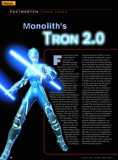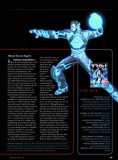From the start, it didn't take long for many of us at Monolith to recognize that a TRON project was a once-in-a-life-time opportunity, not simply because we believed the film would lend itself to great gameplay, but also because of the movie's status as a cultural icon. As a high school student at the time of the original theatrical release, I remember it piquing my interest in computers and videogames. Whether at the time I fully realized the film's impact or not, it certainly planted seeds that flourished later in my life. Since the start of the project, I've spoken to many people about TRON, and I repeatedly get the same kind of story: "It's why I'm into computers," "It's why I'm into 3D graphics," "It's why I'm into gaming."
When Buena Vista Interactive, the core games publishing label of Buena Vista Games, approached Monolith with the TRON project, they were quite up-front about the challenges facing the franchise. While everyone readily agreed it would make a great computer game, generating interest for a title based on a 20-year-old cult classic film that was released ahead of its time might be difficult. Regardless, the project moved forward with great enthusiasm from both Monolith and Buena Vista Interactive. The fact that the game could possibly pave the way for a new TRON film and reignite the franchise was very exciting, injecting a unique motivation into the project that Monolith didn't take lightly.
Overall, Tron 2.0 is a first-person action game that takes place in the digital universe established by the 1982 film TRON. It's important to note that the game does not follow the events seen in the film. Instead, it is a spiritual sibling, or something of a sequel. The core premise of a society mirroring our own that exists in the computer remains intact, as does the phenomenon of a human transporting (or digitizing, as we say in the game) into the computer. Beyond that, the Tron 2.0 universe breaks new ground. Analogies, metaphors, and social consequences reflect how we understand and position computers in our lives today as well as where they may be in the near future. The game tells only one story of a hundred possible stories, making the TRON universe much like the Star Wars and Star Trek universes in that respect. It's this singular quality that makes the TRON franchise timeless.
What Went Right
1. Publisher compatibility.
[…]
2. Identifying iconic elements from the film.
[…]
3. No movie license curse.
[…]
4. Sharing code.
[…]
5. Evolved art direction.
[…]
What Went Wrong
1. Short on initial resources.
[…]
2. Levels unplayable until later in project.
[…]
3. Linking projects.
[…]
4. Loose review process.
[…]
5. Commercial 3D software woes.
[…]
End of Line
One of the more remarkable things about Tron 2.0 is how an eclectic group of individuals came together and weathered many storms to prevail, not with just a finished product, but one of which we can be proud. The dedication and talent the team displayed excites us looking ahead to our next project.
As far as the game itself in concerned, Tron 2.0 was truly the opportunity of a lifetime. I was personally unprepared for the amount of enthusiasm Tron 2.0 garnered from fans and from the press, both in North America and in Europe. We knew all along it was going to be a huge responsibility bringing the TRON franchise into the 21st century. Now that all the hard work is behind us, it's a thrill to know that what we've accomplished can potentially be the seeds from which future projects can grow. And as a huge fan of TRON, I can't wait to see the next tale told inside the world of computers.




